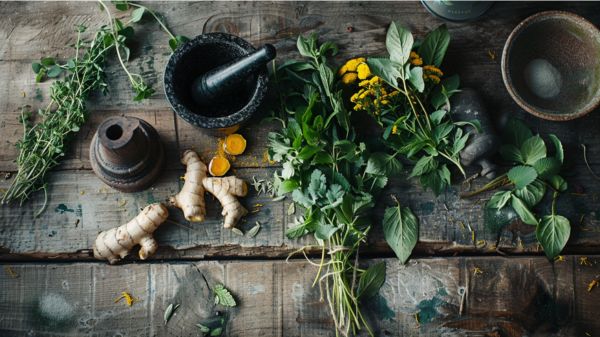11 Key Steps to Identify Active Compounds in Medicinal Plants
Imagine yourself in a lab, meticulously studying medicinal plants. You want to uncover their hidden treasures – the active compounds that hold the key to their therapeutic properties. In this article, we will guide you through 11 key steps to identify these active compounds in medicinal plants.
From plant selection to data analysis, we will explore the precise techniques and analytical methods used to uncover the secrets of nature’s medicine cabinet. Get ready to embark on a journey of discovery and unlock the potential of medicinal plants.
Plant Selection
To select the most suitable plants for analysis, you need to consider their medicinal properties as well as their availability in your region.
Identifying plants with potential benefits requires a thorough understanding of their traditional uses. Traditional knowledge can provide valuable insights into the medicinal properties of various plants. You should gather information from local healers, ethnobotanists, and traditional medicine practitioners to identify plants that have been historically used for specific ailments.
By focusing on plants with established traditional uses, you increase the likelihood of finding active compounds that can be further studied and potentially utilized for medicinal purposes. Additionally, considering the availability of these plants in your region is crucial for practicality and accessibility.
This step ensures that the selected plants can be easily sourced and cultivated for further analysis.
Literature Review
Continue your research by conducting a thorough literature review on the selected medicinal plants, focusing on their active compounds and potential therapeutic applications.
The literature review process is crucial in identifying existing knowledge and research gaps in the field of medicinal plants. To conduct an effective literature review, follow these steps:
- Search for relevant articles, books, and research papers using databases such as PubMed, Scopus, and Google Scholar.
- Analyze the collected literature to identify common active compounds found in the selected medicinal plants.
- Evaluate the potential therapeutic applications of these active compounds based on existing research.
By reviewing the literature, you’ll gain a comprehensive understanding of the active compounds present in the medicinal plants and their potential uses.
This will help you identify any research gaps and contribute to the advancement of knowledge in this field.
Extraction Methods
To effectively extract active compounds from medicinal plants, you must carefully consider the solvent selection, extraction time, and yield optimization.
The choice of solvent is crucial as it determines the efficiency of compound extraction.
Additionally, the extraction time must be optimized to maximize the yield of active compounds while minimizing degradation.
Lastly, yield optimization techniques can further enhance the extraction process, ensuring a higher concentration of active compounds for subsequent analysis.
Solvent Selection
Choose the appropriate solvent for extracting active compounds in medicinal plants. The solvent you select plays a crucial role in the extraction process, as it determines the efficiency with which you can isolate the desired compounds. Consider the following factors when selecting a solvent:
- Solvent Polarity: Different compounds have varying polarities, so it’s important to choose a solvent that can effectively dissolve the target compounds. Matching the polarity of the solvent to the polarity of the compounds enhances the extraction efficiency.
- Extraction Efficiency: The solvent’s ability to extract the active compounds from the plant material is a key consideration. Look for solvents that have high extraction efficiency, as this will ensure maximum recovery of the desired compounds.
- Safety: Lastly, consider the safety aspects of the solvent. Ensure that the chosen solvent is non-toxic, non-flammable, and environmentally friendly.
Extraction Time
To determine the extraction time for active compounds in medicinal plants, consider the efficiency and effectiveness of different extraction methods.
Extraction efficiency refers to the ability of a method to extract the maximum amount of active compounds from the plant material. Different extraction methods, such as maceration, percolation, and Soxhlet extraction, have varying extraction efficiencies due to differences in their mechanisms.
The extraction time plays a crucial role in achieving high extraction efficiency. Longer extraction times can lead to higher yields of active compounds, as more time allows for better solute-solvent interactions and diffusion. However, the temperature also influences the extraction process.
Higher temperatures can increase the extraction rate, but they may also degrade heat-sensitive compounds. Therefore, finding the optimal extraction time that balances extraction efficiency and temperature influence is essential for obtaining the desired active compounds from medicinal plants.
Yield Optimization
For optimizing the yield of active compounds in medicinal plants, you can employ various extraction methods. The choice of extraction method is crucial as it directly affects the quantity and quality of the extracted compounds. Here are three extraction methods that can help in yield optimization:
- Maceration: This method involves soaking the plant material in a solvent for a certain period of time. It’s a simple and cost-effective method but may result in lower yields.
- Soxhlet extraction: In this method, a continuous extraction process is carried out using a Soxhlet apparatus. It ensures maximum extraction efficiency but is time-consuming.
- Supercritical fluid extraction: This method uses supercritical fluids as solvents to extract the active compounds. It offers higher selectivity and yields, but requires specialized equipment.
To optimize the yield, data analysis is crucial. By analyzing the extraction conditions, including solvent type, temperature, and time, you can determine the optimal parameters for maximum yield. This data-driven approach ensures efficient extraction and consistent results.
Phytochemical Analysis
Start by extracting the plant material to obtain the phytochemicals. Phytochemical analysis is a vital step in medicinal plant research as it allows for the identification and characterization of bioactive compounds present in the plant.
This analysis involves the screening of plant extracts to detect the presence of various phytochemical constituents such as alkaloids, flavonoids, terpenoids, and phenolic compounds. Techniques such as thin-layer chromatography (TLC), high-performance liquid chromatography (HPLC), gas chromatography-mass spectrometry (GC-MS), and nuclear magnetic resonance spectroscopy (NMR) are commonly used to analyze and separate these compounds.
The information obtained from phytochemical screening provides valuable insights into the potential therapeutic properties of the medicinal plants and assists in the isolation and identification of active compounds for further study and development of new drugs.
Chromatographic Techniques
Now it’s time to delve into the subtopic of chromatographic techniques, using these methods to separate and analyze the bioactive compounds present in medicinal plants. Chromatographic separation is a powerful tool for identifying and quantifying the various chemical constituents of plant extracts. To achieve successful chromatographic separation, meticulous sample preparation is crucial.
Here are three important components of chromatographic techniques:
- Selection of Chromatographic Method: Different chromatographic techniques such as thin-layer chromatography (TLC), high-performance liquid chromatography (HPLC), and gas chromatography (GC) can be employed depending on the nature of the compounds and the desired analytical objectives.
- Optimization of Mobile Phase: The mobile phase composition, which includes solvents and additives, must be carefully optimized to achieve efficient separation of compounds of interest. This involves adjusting parameters such as pH, polarity, and flow rate.
- Detection and Analysis: After separation, the bioactive compounds can be detected and quantified using various detection methods, such as UV-Vis spectroscopy, mass spectrometry (MS), or fluorescence detection.
Spectroscopic Techniques
To understand spectroscopic techniques for identifying active compounds in medicinal plants, you need to familiarize yourself with the different types of spectroscopy. These include infrared (IR) spectroscopy, nuclear magnetic resonance (NMR) spectroscopy, and mass spectrometry (MS).
Each technique provides unique information about the chemical structure and composition of the compounds present in the plant extracts. By utilizing these compound identification methods, researchers can accurately determine the active components responsible for the medicinal properties of the plants.
Types of Spectroscopy
You can begin by exploring various types of spectroscopy to identify active compounds in medicinal plants. Spectroscopy is a powerful analytical technique that allows researchers to study the interaction of matter with electromagnetic radiation. Two commonly used spectroscopic techniques in the field of medicinal plant research are nuclear magnetic resonance (NMR) and infrared spectroscopy (IR).
- Nuclear Magnetic Resonance (NMR): NMR spectroscopy provides detailed information about the structure and composition of organic compounds. It’s particularly useful in determining the chemical shifts and coupling constants of atoms in a molecule, which can aid in the identification of active compounds in medicinal plants.
- Infrared Spectroscopy (IR): IR spectroscopy is used to analyze the functional groups present in a compound. By measuring the absorption of infrared light by specific chemical bonds, researchers can identify the presence of certain functional groups, such as alcohols, amines, and carbonyls. This information helps in characterizing the active compounds in medicinal plants.
Compound Identification Methods
Start by exploring the different spectroscopic techniques that can be used to identify active compounds in medicinal plants. Compound identification techniques play a crucial role in determining the presence of bioactive molecules in plants. Advanced spectroscopic analysis methods are commonly employed for this purpose.
One commonly used technique is nuclear magnetic resonance (NMR) spectroscopy, which provides detailed information about the structure and chemical environment of compounds. Mass spectrometry (MS) is another powerful tool that helps identify compounds based on their mass-to-charge ratio. Fourier transform infrared spectroscopy (FT-IR) is useful for analyzing functional groups present in compounds. Additionally, ultraviolet-visible (UV-Vis) spectroscopy is employed to determine the electronic transitions of compounds.
These spectroscopic techniques, when used in combination, allow for the efficient identification of active compounds in medicinal plants. By utilizing their unique capabilities, researchers can gain insights into the chemical composition of plant extracts and identify potential therapeutic agents.
Bioassay Screening
One can initiate the process of identifying active compounds in medicinal plants by conducting bioassay screening. This involves using biological assays to test the plant extracts for specific biological activities.
To ensure the accuracy and reliability of the bioassay results, bioassay validation is crucial. This involves establishing the sensitivity, specificity, precision, and reproducibility of the bioassay method.
Additionally, assay development is an important step in bioassay screening. This involves optimizing the assay conditions, such as selecting appropriate cell lines or biological targets, determining the optimal concentrations of plant extracts or compounds, and establishing the appropriate controls.
Compound Isolation
To proceed with the identification of active compounds in medicinal plants, continue by isolating the compounds. Compound isolation is a crucial step in the process of identifying active compounds. During this stage, the compounds of interest are separated from other components present in the plant extract.
The first step in compound isolation is compound purification, which involves the removal of impurities and unwanted compounds. This is achieved through various techniques such as filtration, solvent extraction, and chromatography.
Once the compound is purified, compound characterization is carried out to determine its chemical structure and properties. This involves the use of spectroscopic techniques such as nuclear magnetic resonance (NMR) and mass spectrometry (MS).
Compound isolation is an essential step in the identification of active compounds, as it allows for further analysis and evaluation of their therapeutic potential.
Structural Elucidation
To understand the active compounds in medicinal plants, it’s crucial to employ analytical techniques for structural elucidation. These techniques, such as nuclear magnetic resonance spectroscopy and mass spectrometry, provide valuable information about the chemical structure of the compounds.
Accurate identification of the structure is essential for further studies on their biological activities and potential therapeutic applications.
Analytical Techniques for Structural Elucidation
Start by using analytical techniques for structural elucidation to aid in compound identification. These techniques are crucial in accurately determining the structure of active compounds in medicinal plants.
Here are three sub-lists of analytical techniques commonly used:
Spectroscopic techniques:
- Nuclear Magnetic Resonance (NMR): It provides valuable information about the arrangement of atoms in a compound.
- Mass Spectrometry (MS): It helps determine the molecular weight and fragmentation pattern of the compound.
- Infrared (IR) Spectroscopy: It identifies functional groups present in the compound.
Chromatographic techniques:
- High-Performance Liquid Chromatography (HPLC): It separates and quantifies the components in a mixture.
- Gas Chromatography (GC): It separates volatile compounds based on their boiling points.
- Thin-Layer Chromatography (TLC): It separates compounds based on their affinity to the stationary phase.
Microscopy techniques:
- Scanning Electron Microscopy (SEM): It provides high-resolution images of the compound’s surface.
- Transmission Electron Microscopy (TEM): It reveals the internal structure of the compound at a nanoscale level.
- Confocal Laser Scanning Microscopy (CLSM): It visualizes the distribution of compounds within the plant tissues.
These analytical techniques play a vital role in identifying and characterizing active compounds, enhancing our understanding of their medicinal properties.
Importance of Accurate Identification
Analyzing medicinal plants using analytical techniques for structural elucidation is crucial in accurately identifying active compounds and understanding their medicinal properties. The importance of accurate identification can’t be overstated, as it directly impacts the efficacy and safety of herbal medicines.
Authenticating the identity of medicinal plants ensures that the correct species is used and eliminates the risk of misidentification. Misidentification can lead to the use of incorrect plants, which may contain toxic compounds or lack the desired therapeutic effects. This can have serious consequences for patient health and safety.
Structural elucidation techniques, such as spectroscopy and chromatography, help in identifying the chemical composition of medicinal plants, enabling researchers and practitioners to confidently identify active compounds and understand their mechanisms of action.
Biological Activity Testing
You can identify the active compounds in medicinal plants by conducting biological activity testing. This process involves conducting bioassay screening to evaluate the effects of the plant extracts on living organisms or biological systems.
Here are three key steps in biological activity testing:
- Selection of appropriate bioassays: Choose bioassays that are relevant to the intended use of the medicinal plant. This ensures that the testing accurately reflects the potential therapeutic effects of the plant extract.
- Preparation of plant extracts: Extract the active constituents from the medicinal plant using suitable extraction methods. This step is crucial to obtain concentrated extracts that can be tested in the bioassays.
- Evaluation of biological activity: Test the plant extracts in the selected bioassays to determine their effects on specific biological targets or processes. This step helps identify the active compounds responsible for the observed bioactivity.
Data Analysis
Continue the analysis by examining the data obtained from the biological activity testing of the plant extracts. To effectively analyze the data, it’s crucial to employ data visualization and statistical analysis techniques.
Data visualization provides a visual representation of the data, facilitating the identification of patterns or trends. Various visualization tools, such as scatter plots or bar charts, can be used to display the results.
Statistical analysis, on the other hand, allows for a deeper understanding of the data by applying mathematical models and tests. Descriptive statistics can provide insights into the central tendency and variability of the data, while inferential statistics can help determine if the observed effects are statistically significant.
Ultimately, these analytical approaches will aid in identifying potential active compounds in medicinal plants.
Conclusion
Congratulations! By following these 11 key steps, you now have the tools to successfully identify active compounds in medicinal plants.
Through careful plant selection, literature review, and extraction methods, you have obtained valuable phytochemical data.
Utilizing chromatographic techniques and compound isolation, you have elucidated the structures of these compounds.
By conducting biological activity testing and analyzing the data, you have gained insights into their potential therapeutic effects.
Your meticulous work has paved the way for further research and the development of new medicines.






